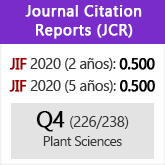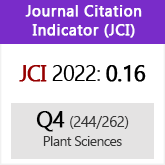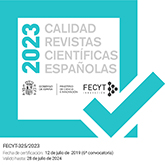Estudio cariológico comparativo del género Helianthemum (Cistaceae): tamaño del cariotipo, simetría del cariotipo y evolución del número de cromosomas
DOI:
https://doi.org/10.3989/ajbm.576Palabras clave:
Cariotipo, ChromEvol, citogenética comparativa, citotaxonomía vegetalResumen
En este estudio analizamos el tamaño y la simetría del cariotipo de un elevado número de especies de Helianthemum y reconstruimos la evolución del número cromosómico. Para ello, analizamos metafases mitóticas de ápices radicales para obtener el número cromosómico, valores de la longitud (monoploide) total del cariotipo (THL), la fórmula cariotípica, el grado de asimetría según la clasificación de Stebbins, el coeficiente de variación intercromosómico de la longitud cromosómica (CVCL) y la asimetría intracromosómica media (MCA), parámetros obtenidos mediante MATO (Measurement and Analysis Tools). Encontramos que la diversificación en Helianthemum no está ligada a cambios en el número de cromosomas, el cual ha evolucionado de forma lenta y constante mediante bajas tasas de pérdida o ganancia de cromosomas. La asimetría del cariotipo es escasa y poco variable en todas las categorías taxonómicas, y existe una predominancia de cromosomas meta o submetacéntricos cuya longitud media a nivel de género es de c. 3 μm. En cambio, la longitud total del cariotipo oscila entre 16,91 y 48,84 μm y H. subg. Plectolobum posee los cariotipos de mayor longitud y simetría. Proponemos la hipótesis de que las diferencias en el tamaño del cariotipo en Helianthemum son consecuencia de reajustes cromosómicos sucedidos bajo presiones selectivas.
Descargas
Citas
Albaladejo R.G., Martín-Hernanz S., Reyes-Betancort J.A., Santos-Guerra A., Olangua-Corral M. & Aparicio A. 2021. Reconstruction of the spatio-temporal diversification and ecological niche evolution of Helianthemum (Cistaceae) in the Canary Islands using genotyping-by-sequencing data. Annals of Botany 127: 597-611. https://doi.org/10.1093/aob/mcaa090 PMid:32386290 PMCid:PMC8052925
Altinordu F., Peruzzi L., Yu Y. & He X. 2016. A tool for the analysis of chromosomes: KaryoType. Taxon 65: 586-592. https://doi.org/10.12705/653.9
Aparicio A. & Albaladejo R.G. 2017. On the identity of Helianthemum mathezii and H. pomeridianum (Cistaceae). Anales del Jardín Botánico de Madrid 74: e060. https://doi.org/10.3989/ajbm.2472
Aparicio A, Escudero M., Valdés-Florido A., Pachón M., Rubio E., Albaladejo R.G., Martín-Hernanz S. & Pradillo M. 2019. Karyotype evolution in Helianthemum (Cistaceae): dysploidy, achiasmate meiosis and ecological specialization in H. squamatum, a true gypsophile. Botanical Journal of the Linnean Society 191: 484-501. https://doi.org/10.1093/botlinnean/boz066
Aparicio A., Martín-Hernanz S., Parejo-Farnés C., Arroyo J., Lavergne S., Yeşilyurt E.B., Zang M-L., Rubio E. & Albaladejo R.G. 2017. Phylogenetic reconstruction of the genus Helianthemum (Cistaceae) using plastid and nuclear DNA-sequences: systematic and evolutionary inferences. Taxon: 66: 868-885. https://doi.org/10.12705/664.5
Cacho N.I., McIntyre P.J., Kliebenstein D.J. & Strauss S.Y. 2021. Genome size evolution is associated with climate seasonality and glucosinolates, but not life history, soil nutrients or range size, across a clade of mustards. Annals of Botany 127: 887-902. https://doi.org/10.1093/aob/mcab028 PMid:33675229 PMCid:PMC8225284
Carta A., Bedini G. & Peruzzi L. 2018. Unscrambling phylogenetic effects and ecological determinants of chromosome number in major angiosperm clades. Scientific Reports 8: 14258. https://doi.org/10.1038/s41598-018-32515-x PMid:30250220 PMCid:PMC6155329
Dalgaard V. 1986. Chromosome studies in flowering plants from Macaronesia. Anales del Jardín Botánico de Madrid 43: 83-111.
Elliott T.L., Zedek F., Barrett R.L., Bruhl J.J., Escudero M., Hroudová Z., Joly S., Larridon I., Luceño M., Márquez-Corro J.I., Martín-Bravo S., Muasya A. M., Šmarda P., Thomas W.W., Wilson K.L. & Bureš P. 2022. Chromosome size matters: genome evolution in the cyperid clade. Annals of Botany 130: 999-1014. https://doi.org/10.1093/aob/mcac136 PMid:36342743
Escudero M., Martín-Bravo S., Mayrose I., Fernández-Mazuecos M., Fiz-Palacios O., Hipp AL., Pimentel M., Jiménez-Mejías P., Valcárcel V., Vargas P. & Luceño M. 2014. Karyotypic changes through dysploidy persist longer over evolutionary time than polyploidy changes. PLoS One 9: e85266. https://doi.org/10.1371/journal.pone.0085266 PMid:24416374 PMCid:PMC3887030
Glick L. & Mayrose I. 2014. ChromEvol: assessing the pattern of chromosome number evolution and the inference of chromosome number evolution and the inference of polyploidy along a phylogeny. Molecular Biology and Evolution 31: 1914-1922. https://doi.org/10.1093/molbev/msu122 PMid:24710517
Goldblatt P. & Johnson D.E. 1979. Index to plant chromosome numbers. Missouri Botanical Garden, St. Louis. Website: http://www.tropicos.org/Project/IPCN.
Greilhuber J. & Leitch I.J. 2013. Genome size and the phenotype. In Leitch I.J., Greilhuber J., Doležel J. & Wendel J. (eds.), Plant genome diversity 2: 323-344. Springer-Verlag, Vienna. https://doi.org/10.1007/978-3-7091-1160-4_20
Guerra M. 2012. Cytotaxonomy: The end of childhood. Plant Biosystems 146: 703-710. https://doi.org/10.1080/11263504.2012.717973
Ho L.S.T. & Ane C. 2014. A linear-time algorithm for Gaussian and non-Gaussian trait evolution models. Systematic Biology 63: 397-408. https://doi.org/10.1093/sysbio/syu005 PMid:24500037
Ives A.R. & Garland T. 2010. Phylogenetic logistic regression for binary dependent variables. Systematic Biology 59: 9-26. https://doi.org/10.1093/sysbio/syp074 PMid:20525617
Levan A., Fredga K. & Sandberg A.A. 1964. Nomenclature for centromeric position on chromosomes. Hereditas 52: 201-220. https://doi.org/10.1111/j.1601-5223.1964.tb01953.x
Levin D.A. 2002. The role of chromosomal change in plant evolution. Oxford Series in Ecology and Evolution. Oxford University Press, Oxford and New York.
Lysák M.A., Berr A., Pecinka A., Schmidt R., McBreen K. & Schubert I. 2006. Mechanisms of chromosome number reduction in Arabidopsis thaliana and related Brassicaceae species. Proceedings of the National Academy of Sciences of the United States of North America 103: 5224-5229. https://doi.org/10.1073/pnas.0510791103 PMid:16549785 PMCid:PMC1458822
Martín-Hernanz S., Aparicio A., Fernández-Mazuecos M., Rubio E., Reyes-Betancort A., Santos-Guerra A., Olangua-Corral M. & Albaladejo R.G. 2019. Maximize resolution or minimize error? Using Genotyping-By-Sequencing to investigate the recent diversification of Helianthemum (Cistaceae). Frontiers in Plant Science 10: 1416. https://doi.org/10.3389/fpls.2019.01416 PMid:31781140 PMCid:PMC6859804
Martín-Hernanz S., Velayos M., Albaladejo R.G. & Aparicio A. 2021a. Systematic implications from a robust phylogenetic reconstruction of the genus Helianthemum (Cistaceae) based on genotyping-by-sequencing (GBS) data. Anales del Jardín Botánico de Madrid 78: e113. https://doi.org/10.3989/ajbm.2601
Martín-Hernanz S., Albaladejo R.G., Lavergne S., Rubio E., Grall A. & Aparicio A. 2021b. Biogeographic history and environmental niche evolution in the Palearctic genus Helianthemum (Cistaceae). Molecular Phylogenetics and Evolution 163: 107238. https://doi.org/10.1016/j.ympev.2021.107238 PMid:34197899
Martín-Hernanz S., Albaladejo R.G., Lavergne S., Rubio E., Marín-Rodulfo M., Arroyo J. & Aparicio A. 2023. Strong conservatism of floral morphology during the rapid diversification of the genus Helianthemum (Cistaceae). American Journal of Botany e16155. https://doi.org/10.1002/ajb2.16155 PMid:36912727
Mayrose I., Baker M.S. & Otto S. 2010. Probabilistic models of chromosome number evolution and the inference of polyploidy. Systematic Biology 59: 132-144. https://doi.org/10.1093/sysbio/syp083 PMid:20525626
Paszko B. 2006. A critical review and a new proposal of karyotype asymmetry indices. Plant Systematics and Evolution 58: 39-48. https://doi.org/10.1007/s00606-005-0389-2
Pellicer J., Hidalgo O., Dodsworth S. & Leitch I.J. 2018. Genome size diversity and its impact on the evolution of land plants. Genes 9: 88. https://doi.org/10.3390/genes9020088 PMid:29443885 PMCid:PMC5852584
Pérez-García F. & González-Benito M.E. 2006. Seed germination of five Helianthemum species: effect of temperature and presowing treatments. Journal of Arid Environments 65: 688-693. https://doi.org/10.1016/j.jaridenv.2005.10.008
Peruzzi L. & Eroğlu H. 2013. Karyotype asymmetry: again, how to measure and what to measure? Comparative Cytogenetics 7: 1-9. https://doi.org/10.3897/compcytogen.v7i1.4431 PMid:24260685 PMCid:PMC3833747
Quiner Y. & Gilbert M.G. 2007. Helianthemum. In Wu Z.Y., Raven P.H. & Hong D.Y. (eds.), Flora of China, 13: 70. Science Press, Beijing; Missouri Botanical Garden Press, St. Louis. Website: http://www.eFloras.org [last accessed Oct 2022].
Rice A., Glick L., Abadi S., Einhorn M., Kopelman N.M., Salman-Minkov A., Mayzel J., Chay O. & Mayrose I. 2015. The Chromosome Counts Database (CCDB) - a community resource of plant chromosome numbers. New Phytologist 206: 19-26. https://doi.org/10.1111/nph.13191 PMid:25423910
Schubert I. & Lysák M.A. 2011. Interpretation of karyotype evolution should consider chromosome structural constraints. Trends in Genetics 27: 207-216. https://doi.org/10.1016/j.tig.2011.03.004 PMid:21592609
Snow R. 1963. Alcoholic hydrochloric acid-carmine as a stain for chromosomes in squash preparations. Stain Technology 38: 9-13. https://doi.org/10.3109/10520296309061161 PMid:13989724
Soltis D.E., Soltis P.S., Endress P.K. & Chase M.W. 2005. Phylogeny and evolution of Angiosperms. Sinauer Associates, Washington.
Stace C.A. 2000. Cytology and cytogenetics as a fundamental taxonomic resource for the 20th and 21st centuries. Taxon 49: 451-477. https://doi.org/10.2307/1224344
Stebbins G.L. 1971. Chromosomal evolution in higher plants. Edward Arnold, London.
Tjio J.H. & Levan A. 1950. The use of oxyquinoline in chromosome analysis. Anales de la Estación Experimental Aula Dei 2: 21-64.
Weiss-Schneeweiss H. & Schneeweiss G.M. 2013. Karyotype diversity and evolutionary trends in angiosperms. Genome size and the phenotype. In Leitch I.J., Greilhuber J., Doležel J. & Wendel J. (eds.), Plant genome diversity 2: 209-230. Springer-Verlag, Vienna. https://doi.org/10.1007/978-3-7091-1160-4_13
Zhao Y-Z., Cao R. & Zhu Z-Y. 2000. A new species of Helianthemum. Acta Phytotaxonomica Sinica 38: 294-296.
Publicado
Cómo citar
Número
Sección
Licencia
Derechos de autor 2023 Consejo Superior de Investigaciones Científicas (CSIC)

Esta obra está bajo una licencia internacional Creative Commons Atribución 4.0.
© CSIC. Los originales publicados en las ediciones impresa y electrónica de esta Revista son propiedad del Consejo Superior de Investigaciones Científicas, siendo necesario citar la procedencia en cualquier reproducción parcial o total.Salvo indicación contraria, todos los contenidos de la edición electrónica se distribuyen bajo una licencia de uso y distribución “Creative Commons Reconocimiento 4.0 Internacional ” (CC BY 4.0). Puede consultar desde aquí la versión informativa y el texto legal de la licencia. Esta circunstancia ha de hacerse constar expresamente de esta forma cuando sea necesario.
No se autoriza el depósito en repositorios, páginas web personales o similares de cualquier otra versión distinta a la publicada por el editor.
Datos de los fondos
Ministerio de Economía y Competitividad
Números de la subvención CGL2014-52459-P, CGL2017-82465-P and PID2020-116355GB-I00
Türkiye Bilimsel ve Teknolojik Araştırma Kurumu
Números de la subvención 116Z446
Papanin Institute for Biology of Inland Waters, Russian Academy of Sciences
Números de la subvención 121051100099-5

















